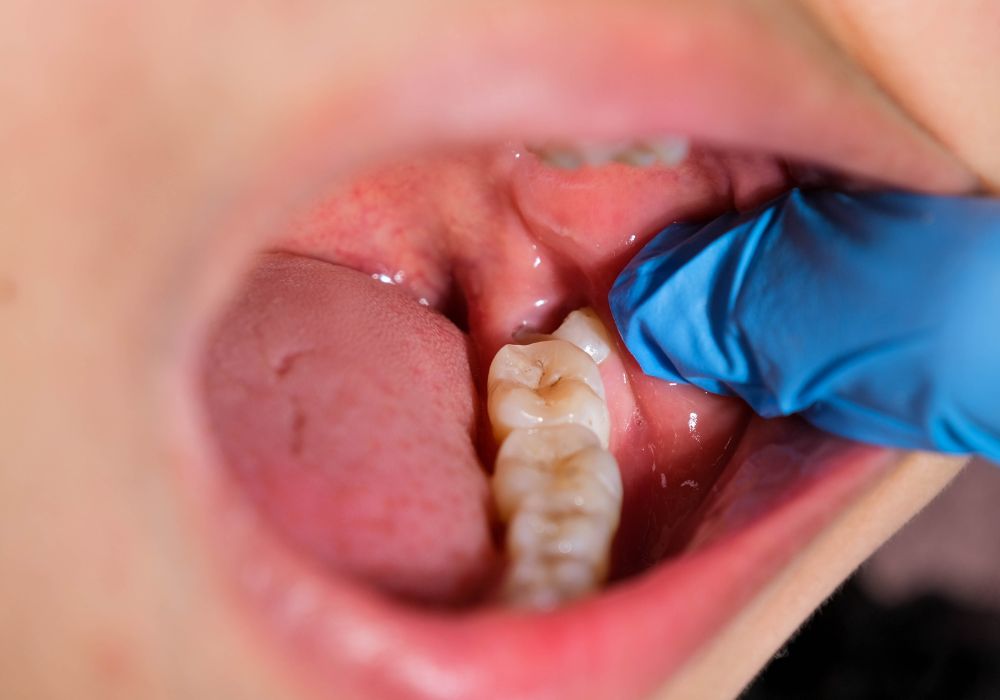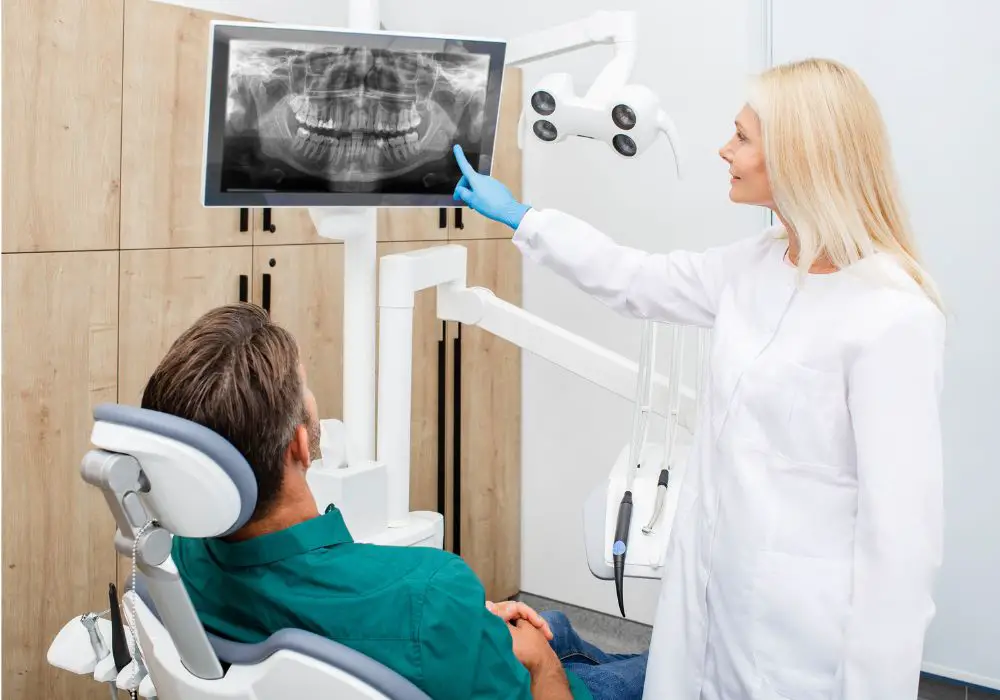Wisdom teeth are the third and final set of molars that erupt in the late teens to early 20s. These teeth are located in the far back corners of the mouth. When wisdom teeth come in, they may emerge normally aligned or impacted. But in some cases, they can suddenly start feeling loose or wiggly. This raises the question of whether a loose wisdom tooth can be fixed, or if extraction is necessary.
Causes and Risk Factors for Loose Wisdom Teeth

There are several potential reasons a wisdom tooth may become loose. Understanding the underlying cause is key to determining appropriate treatment.
Pericoronitis
One of the most common causes of a loose wisdom tooth is pericoronitis. This refers to inflammation and infection of the gum tissues surrounding a partially impacted wisdom tooth.
As the tooth begins to emerge, the gum tissue can partially cover it. Bacteria and food debris then get trapped under this flap of tissue and cause swelling, pain, and infection in the gums.
If severe, pericoronitis can damage the periodontal ligament that holds the tooth secure in the jawbone. This ligament breakdown allows the tooth to feel loose and wiggly. Those at highest risk of pericoronitis include:
- People with poor oral hygiene
- Smokers
- Those with crowded wisdom teeth
- Individuals with partially erupted wisdom teeth
- Patients who have undergone radiation therapy
Periodontal Disease
Chronic periodontal or gum disease can also undermine the stability of wisdom teeth. Periodontitis causes damage to the gums, periodontal ligament, and jawbone that support the teeth.
As inflammation and infection spread, the tissues and bone around teeth are broken down. In advanced cases, this loss of support can lead to looseness of wisdom teeth along with other teeth.
Risk factors for periodontitis affecting wisdom teeth include:
- Poor oral hygiene habits
- Smoking or tobacco use
- Diabetes, HIV, or other conditions that impair healing
- Crooked teeth or dental crowding
- Genetic susceptibility
If periodontal disease is not treated properly, wisdom teeth will progressively loosen and eventually be lost.
Tooth Decay
Untreated tooth decay undermines the structure of wisdom teeth over time. As cavities become larger, they weaken the outer enamel and inner dentin layers of the tooth.
Advanced decay can reach the inner pulp tissue and damage the root of the tooth. This decay process also causes worsening infection, inflammation, and loss of supporting jawbone. The end result can be a wisdom tooth that feels loose and ready to fall out.
Risk factors for severe wisdom tooth decay include:
- Poor oral hygiene
- Frequent consumption of sugary foods and drinks
- Dry mouth from medications or health conditions
- Deep grooves or pits in the chewing surface
- Existing dental fillings or crowds that are hard to clean around
Cysts and Tumors
Fluid-filled cysts sometimes form around the roots of wisdom teeth. These cysts gradually expand in size, destroying surrounding bone and weakening the roots. This eventually leads to a loose tooth.
In rare cases, benign or malignant tumors affecting the gums, jaws, or tooth roots can also cause wisdom tooth loosening.
Trauma
Any injury or trauma to the jaw and wisdom teeth can result in damage leading to tooth looseness. For example, a knock to the jaw during sports or a motor vehicle accident can displace teeth and rupture periodontal ligaments. Severe injury may immediately make a wisdom tooth feel loose or wiggly.
Determining Prognosis and Appropriate Treatment

Whether a loose wisdom tooth can be successfully saved depends on the severity of damage and how easily the cause can be corrected. Mild cases caught early stand the best chance of stabilizing the tooth and avoiding extraction.
Mild Pericoronitis
When a wisdom tooth is mildly loose due to pericoronitis alone, the inflammation may be reversible. Removing trapped bacteria and food, along with antibiotics and anti-inflammatory medications can resolve many cases. The tooth may then tighten back up on its own.
Moderate Gum Disease
Treating gum disease in the early to moderate stages has a good chance of firming up a loose wisdom tooth. This may involve deep cleanings, gum surgery, and prescription antimicrobial rinses. The tissues can reattach and bone lost to periodontitis may regenerate.
Small Cavities
Shallow decay on wisdom teeth can sometimes be restored with fillings, sealants, or crowns. This may save the tooth and stabilize it. But larger cavities already weakening the tooth roots often require extraction.
Mild Cysts
If a cyst appears to be the sole cause of wisdom tooth looseness, draining the fluid and removing the cyst lining can allow the tooth to regain stability. However, cysts tend to recur and may still ultimately need extraction.
Severe Damage
Any of the above problems – pericoronitis, gum disease, decay, cysts, or trauma – become harder to fix when severe. Extensive damage usually means a wisdom tooth cannot be salvaged. The tooth needs to be extracted before complications can develop.
Extraction as the Most Common Treatment
Due to the difficulty of thoroughly accessing, cleaning, and restoring wisdom teeth, extraction is the most common and reliable treatment for a loose wisdom tooth. The risks of leaving the tooth untreated usually outweigh any benefits of attempting other procedures to save it.
Extraction allows full removal of the tooth roots and surrounding cysts or infected gum tissue. This can be performed under local or general anesthesia, depending on the tooth’s position. Following extraction, antibiotics and pain medication may be prescribed.
The socket fills in with bone over several months. Healing typically progresses well if proper hygiene and post-op care instructions are followed.
Consequences of Leaving a Loose Wisdom Tooth Untreated

It is generally unwise to ignore a wisdom tooth that has become loose or wiggly. Potential complications of leaving the problem unchecked include:
- Worsening infection that can spread to the jawbone, other teeth, or neck spaces
- Abscesses, cysts, or benign tumors forming from trapped bacteria or tissue
- Eventual loss of the tooth as the condition progresses
- Decay spreading to adjacent healthy teeth
- Bone loss from persistent inflammation and periodontal disease
- Tooth fragments being aspirated or swallowed if the tooth falls out spontaneously
Prompt extraction is usually the safest course of action when dealing with a loose wisdom tooth. This minimizes chances of the issues above.
FAQs About Loose Wisdom Teeth
Can you leave a loose wisdom tooth alone?
It is not recommended to leave a loose wisdom tooth untreated. Doing so will likely allow the problem to worsen over time. Infection, pain, and eventual tooth loss are probable if no action is taken.
Do loose wisdom teeth tighten back up sometimes?
They can potentially tighten back up if the looseness is due to mild, reversible issues like minor pericoronitis or recent trauma with no major tissue damage. However, moderate to severe periodontitis, decay, cysts, or injury often cause progressive loosening that requires extraction.
How long is it safe to leave a loose wisdom tooth before extracting it?
It is best to have a loose wisdom tooth evaluated promptly by a dentist. If it is determined that the tooth cannot be successfully stabilized, extraction should be scheduled as soon as reasonable depending on symptoms and scheduling. Severely loose teeth should not be left for more than 1-2 weeks at most.
Is it possible to remove a very loose wisdom tooth at home?
No, you should never attempt to remove a wisdom tooth yourself. Doing so risks leaving root fragments behind, fracturing the jawbone, and serious complications like worsened infection and damage to nearby teeth and nerves. Extraction should only be done by an oral surgeon or dentist.
How do you know when it is definitely time to remove a wisdom tooth?
Signs that wisdom tooth extraction is definitely needed include severe looseness, uncontrolled or spreading infection, cysts or tumors present, damage to adjacent teeth, or the tooth interfering with proper dental alignment and bite function. An oral surgeon can best determine when a wisdom tooth is no longer salvageable.
Conclusion
A sudden onset of wisdom tooth looseness should prompt a prompt dental examination. While mild cases may be reversible with antibiotics, gum therapy, or restorations, significant loosening usually indicates advanced damage requiring extraction. The risks of retaining a seriously loose wisdom tooth typically outweigh any benefits of trying to save it. With experienced surgical extraction and good post-op care, healing and outcomes are typically positive.







